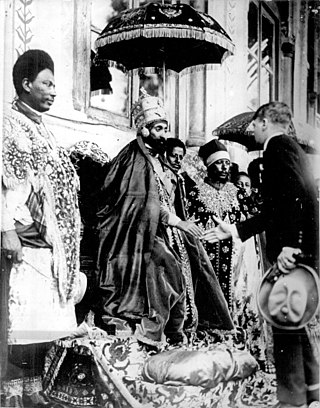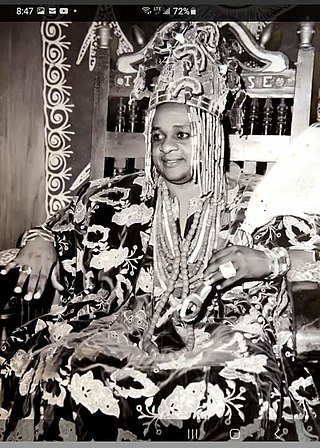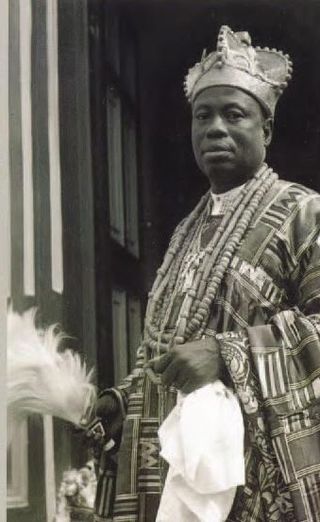
The Oyo Mesi is the privy council of Oyo, a Yoruba traditional state in Southwestern Nigeria. It dates to the medieval period, when it served as the government of a powerful pre-colonial state that was known as the Oyo empire. [1]

The Oyo Mesi is the privy council of Oyo, a Yoruba traditional state in Southwestern Nigeria. It dates to the medieval period, when it served as the government of a powerful pre-colonial state that was known as the Oyo empire. [1]
The Oyo Mesi was made up of the most powerful noblemen in imperial Oyo. No emperor, or Alaafin of Oyo , was capable of being enthroned in the capital without the prior consent of and performance of rituals by these seven titleholders. They were a ruler's principal advisors and sacred officiants, and also served a variety of judicial and administrative functions in his realm.
Led by the Bashorun (or hereditary "Prime Minister"), the Oyo Mesi were also expected to serve as a check on the despotic authority of each individual emperor that they crowned. In the event of any given reign having descended into tyranny, the Bashorun - after having put the matter to a vote in the Oyo Mesi previously - was expected to perform a traditional rite during which he would bring a calabash (which was to be either empty or laden with the eggs of a parrot) and present it to his monarch. On seeing that this had been done, the Alaafin was then obligated to essentially abdicate by way of ritual suicide shortly thereafter. After his burial, it was then left to the Oyo Mesi to begin the process all over again by replacing him with another member of the imperial family.
These wide powers that the Oyo Mesi had were checked in turn by the Ogboni, a subordinate council of noble elders that were sworn to the service of the Earth goddess. In matters of war, the Oyo Mesi were also supported by the Eso Ikoyi warrior caste, who they indirectly commanded on the battlefield by way of its field commander, the Are-Ona-Kakanfo .
This organizational structure survived the fall of the old empire during the Yoruba civil war in the 19th century, and exists now in the ceremonial monarchy of contemporary Oyo. [2]
The following are the titles of the Oyo Mesi chiefs. Each has his own inalienable functions in the realm (although many of these responsibilities - such as the Samu's needing to commit ritual suicide - are now dormant), and all are collectively the Oyo equivalent of the Iwarefa in other Yoruba kingdoms:

The Oyo Empire was a Yoruba empire in West Africa. It was located in present-day southern Benin and western Nigeria. The empire grew to become the largest Yoruba-speaking state through the organizational and administrative efforts of the Yoruba people, trade, as well as the military use of cavalry. The Oyo Empire was one of the most politically important states in Western Africa from the mid-17th to the late 18th century and held sway not only over most of the other kingdoms in Yorubaland, but also over nearby African states, notably the Fon Kingdom of Dahomey in the modern Republic of Benin on its west.
Abiodun was an 18th-century alaafin, or king, of the Oyo people in what is now Nigeria.

Alaafin, or The custodian of the Palace in the Yoruba language, is the title of the king of the medieval Oyo empire and present-day Oyo town of West Africa. It is the particular title of the Oba (king) of the Oyo. It is sometimes translated as "emperor" in the context of ruler of empire. He ruled the old Oyo Empire, which extended from the present-day Benin republic to Nigeria, originating from states in the South East and West to the North. The people under him are called Yoruba people and spoke the Yoruba Language.
Chief Oluyole was a distinguished, dominating army commander from Oyo. He rose to fame as Bashorun, a title he subsequently made famous, and was one of the leaders who contributed immensely to the military and economic development of Ibadan during the city's formative years, a period which had its share of tumult and uncertainty.
Ojigi was Alaafin of the Yoruba Oyo Empire from 1724-1735.
Orompoto was an Alaafin of the Yoruba Oyo Empire. The empire of which she ruled is located in what is modern day western and north-central Nigeria.
Odarawu was an Alaafin of the Oyo Empire, who ruled briefly during the late seventeenth century. He was reportedly the first Alaafin to be rejected by the Oyo Mesi.
Kanran, or Karan, was an Alaafin of the Oyo Empire. He succeeded Oba Odarawu.
Aganju of Oyo was a Yoruba emperor of the Oyo state, in present-day Nigeria. He was said to have been the fourth Alaafin or old Oyo.
Gberu was an Alaafin of the Yoruba Oyo Empire. He was on the throne from 1730 to 1746.
The Olota of Ota is the traditional ruler and sovereign of Ota, Ogun State, Nigeria.

Coronations in Africa are held, or have been held, in or amongst the following countries, regions and peoples:

Lamidi Olayiwola Adeyemi III was the Alaafin, or traditional ruler, of the Yoruba town of Oyo and rightful heir to the throne of its historic empire.
Afonja of Ilorin was the "Are-Ona-Kakanfo", or chief military leader, of the Oyo Empire. Laderin, the great-grandfather of Afonja, was the founder of Ilorin city. He was succeeded by his son, Pasin, a powerful warrior who became a threat and target to, Basorun Gaha, because of his rising profile. He was driven into exile and killed. Alagbin, his son was made King. After the death of Alagbin, his son, Afonja, took over. These were the only four Yoruba kings in Ilorin.
Sango Festival is an annual festival held among the Yoruba people in honour of Sango, a thunder and fire deity who was a warrior and the third king of the Oyo Empire after succeeding Ajaka his elder brother. Renamed in 2013 to World Sango Festival by the government of Oyo State, the festival is usually held in August at the palace of the Alaafin of Oyo and also observed in over forty countries around the world.
Siyanbola Ladigbolu was Alaafin of Oyo from January 1911 to 1944. He was the Alaafin of Oyo when Northern and Southern protectorates of Nigeria were amalgamated in 1914.
Onisile was an Alaafin of the Yoruba Oyo Empire during the eighteenth century.

The Nigerian Chieftaincy is the chieftaincy system that is native to Nigeria. Consisting of everything from the country's monarchs to its titled family elders, the chieftaincy as a whole is one of the oldest continuously existing institutions in Nigeria and is legally recognized by its government.
The Yoruba Revolutionary Wars, otherwise known as the Yoruba Civil Wars, were a series of conflicts that engulfed the Yoruba-speaking areas of West Africa in the late 18th and early 19th centuries. Robin Law summarizes the causes of the wars as the disintegration of the old Oyo Empire after the death of Alaafin Abiodun in 1789 and a resurgence of long-standing quarrels between the provincial chiefs over various issues. The root of the first disagreements can be traced to the feud between two noble houses; Laderin, based in Ilorin, and Yamba, based in the capital at Oyo-Ile. The conflict was also exacerbated by a Muslim slave rebellion led by a Fulani Muslim cleric, Shehu Alimi, and sponsored by the Aare Ona Kakanfo, Afonja, a descendant of Laderin, the founder of Ilorin, in 1817.